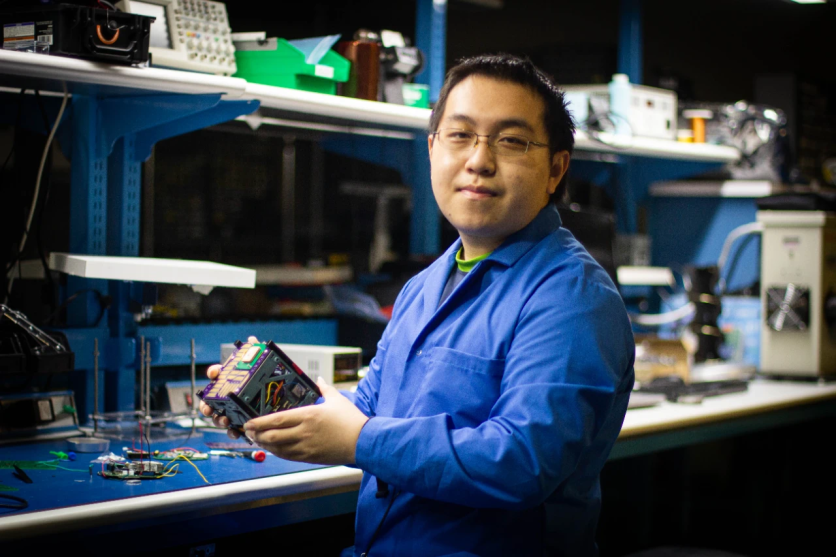
"The future of UAV technology depends not just on advanced electronics but on rethinking the very foundations of design," says Guankai Zhai, co-founder and CEO of LudaTech. This concept inspired the creation of AeroHover, an autonomous airship that promises to transform the UAV market.
Unmanned aerial vehicles (UAVs), commonly called drones, are popular in various industries, including agriculture and aerial photography. However, typical UAVs have certain limitations. Their limited battery life limits operational duration, making them unsuitable for long-term applications. The noise from the rotors can also be disruptive, restricting its application in noise-sensitive areas. Safety issues are also prevalent as the fast-spinning rotors risk harm and damage during malfunctions.
AeroHover tackles conventional UAV constraints. Unlike traditional drones, it is the first to use a blimp form. This unique method marks a fundamental change in UAV technology, with the blimp architecture offering multiple advantages that address the typical shortcomings of quadcopters.
Advantages of AeroHover's Blimp Design
AeroHover's long battery life distinguishes it from conventional UAVs, which usually run for less than an hour on a single charge. "Our blimp design lets AeroHover reach flight times exceeding five hours, so it's perfect for long missions," explains Zhai.
This extended operational duration creates a broad range of options for uninterrupted aerial presence. For example, AeroHover can be used for ongoing wildlife monitoring, extensive environmental studies, and more extended security patrols without the frequent need for recharging. This capability dramatically increases efficiency and production because controllers can do extensive research, compile more data, and keep constant surveillance over more expansive locations. This makes AeroHover an ideal tool because it increases the scope and quality of missions and lowers operating expenses and downtime.
AeroHover also excels in safety. The blimp's buoyancy guarantees low impact in the unlikely case of a collision, lowering the danger of damage to the UAV and its surroundings. With its design, it is appropriate for usage in crowded regions, sensitive situations, and close to essential assets, unlike conventional drones, which might inflict significant damage upon impact.
AeroHover's safety and noise advantages benefit urban deliveries as well. This makes it suitable for transporting goods in densely populated areas where traditional drones may be too risky or disruptive.
Overcoming Challenges
Despite its innovative design and numerous benefits, the development of AeroHover was not without challenges. One of the significant hurdles was developing novel control systems for the blimp. Unlike traditional drones, which rely on fast-spinning rotors for stability and maneuverability, AeroHover's blimp design required entirely new control mechanisms to manage its flight dynamics effectively.
Another challenge was the blimp's vulnerability to air turbulence. Traditional drones can quickly adjust their position to counteract gusts of wind, but a blimp's larger surface area makes it more susceptible to being pushed off course. Developing systems to mitigate the effects of air turbulence and maintain stable flight was a complex and ongoing task.
The current trade war between the US and China also poses significant obstacles. "The disturbances to the supply chain caused by these trade restrictions were a major setback," says Zhai. "Securing the necessary components and materials for AeroHover's development became a challenge. However, our team's resilience and commitment to innovation kept us moving forward."
Setting New Standards
In 2023, the UAV market saw a notable increase in demand for drones with enhanced capabilities. Driven by technological advancements and increasing aerial surveillance needs, the global drone market is projected to reach USD 54.6 billion by 2030.
Key trends include improvements in artificial intelligence (AI) integration, enabling drones to operate autonomously with minimal human input, enhanced battery technology for longer flight times, and broader applications across industries such as agriculture and logistics. These developments indicate a bright future for UAVs in various sectors.
"By addressing common pain points of traditional UAVs, our blimp design could influence the future of UAV technology," explains Zhai. "The extended battery life, silent operation, and improved safety margins make AeroHover and its approach very appealing across many industries."
AeroHover is a marked development that combines the latest advances with solutions for conventional UAVs' inherent restrictions. LudaTech'sl blimp design is fresh in the industry and promises a future where UAVs are safer, quieter, and more efficient than ever.
ⓒ 2025 TECHTIMES.com All rights reserved. Do not reproduce without permission.





